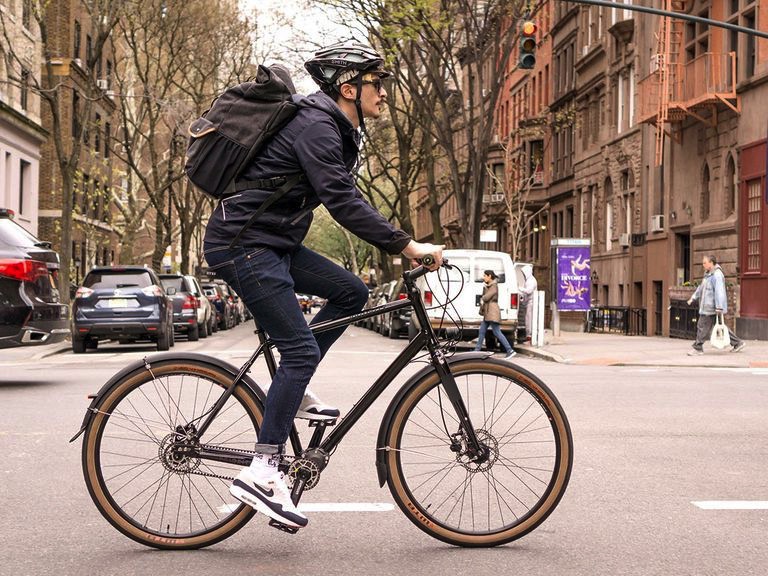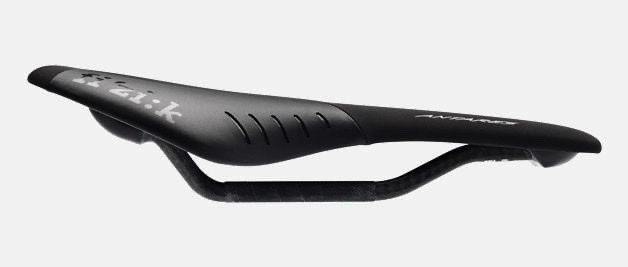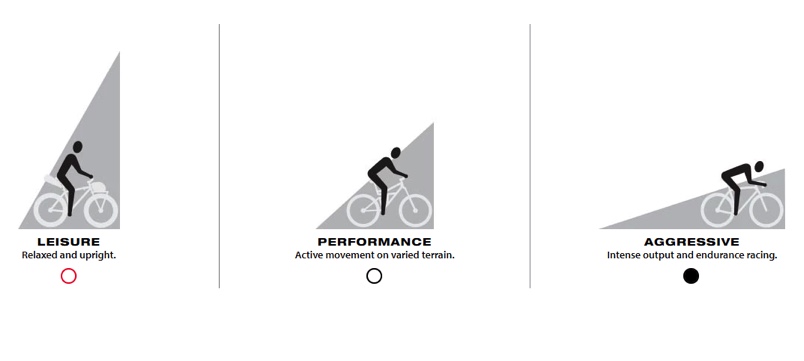Tricks For Choosing a Mountain Bike Saddle – a Bike Saddle Fitting Guide
Whether you're an amateur or professional cyclist, choosing your bike saddle can be a very daunting task. There are several elements to consider for the best and most comfortable riding experience. These factors will affect the type of saddle you get as well as the saddle shape, saddle material, saddle width, and saddle height. So, we've put together this ultimate guide to help you when you’re choosing a mountain bike saddle for you.
Choose a saddle made of cotton material with a wave shape for downhill mountain bike riding, a saddle made of leather material with a slight wave shape for cross-country riding, and a saddle made of synthetic material with a flat shape for city riding.
According to this article from Physiopedia on Cycling Biomechanics, the key contact points in cycling are the feet on the pedals, the hands on the handlebar, and the pelvis on the saddle. Riders spend most of their time on the saddle while riding and there is a need to optimize comfort levels. You'll have to consider a number of factors, including your body shape and size, riding style, posture, discipline, and weather conditions. For more information, check out our easy steps to improve mountain bike saddle comfort.
Determine What Type of Mountain Bike Riding You Enjoy
Your type of riding is a crucial consideration when choosing the right saddle that offers maximum comfort and performance. Some types will require you to prioritize comfort, while others will need you to prioritize efficiency and performance. From the saddle material to the saddle shape, different features will be best suited for different types of riding.
Common types of mountain bike riding are downhill racing, cross-country riding, and city commuting. A curved saddle with flexible wing panels and shells is comfortable for downhill racing since it absorbs more shock. Use a leather saddle with a cutout for long cross-country rides. Flat, synthetic saddles are ideal for city riding since they don’t need to be broken in.
Here are the main types of mountain bike riding:
Type 1. Downhill Racing
If you're doing a lot of downhill racing, you'll want to consider curved saddles with a wave shape like this. These saddles secure you in place and provide support and stability while descending twisty trails. They keep you centered on the bike and allow for maximum power transfer. In addition, the curved lip at the back pushes against your body when you want that maximum control. You should also look out for other features like flexible wing panels and shells to absorb impact and vibrations on trails.
The saddle should also be sturdy and durable to handle rocky descents. Cotton materials are particularly suitable for downhill rides. These saddles offer good shock absorption, adequate control, and breathability. In addition, they offer sufficient grip to prevent you from sliding off while navigating the descents. Saddles like these that have rails made of steel are also great options due to their strength and easy maintenance.
If you would like to know more about safety check out our tips for buying downhill mountain bike armor.
Type 2. Cross Country Riding
Cross-country bike saddles should be well suited for long-distance endurance rides. Saddles like these that are made of leather are excellent choices as they are strong, flexible, responsive, and resistant to wear and tear. Although they require a break-in period, leather saddles gradually mold to the rider's body, ensuring a custom fit. In addition, they are resilient and sturdy and can handle miles and miles of off-road riding. Long-distance riders also prefer waved saddles as they allow for a more aerodynamic riding posture.

Cutouts, relief channels, and central grooves in saddles like this, are also important features for this type of riding. They help alleviate and relieve pressure on the backside and improve blood circulation. This will reduce the pain and numbness associated with longer rides. Lightweight shells or chassis made of carbon fiber in saddles like this, help save weight for extended rides. It is also best to get saddles with mounting brackets as they allow you to attach extra cargo and gear directly to the bike.
Type 3. City Riding
For recreational riders cycling on paved roads, synthetic saddles are the preferred option. This is because they are lightweight, water-resistance, and low maintenance. In addition, they typically do not require any breaking in and offer optimum comfort for short and casual urban rides. They are also quite easy to install and replace. These saddles could have foam cushioning like this one, or gel cushioning.
Flat saddles are the options to go for if you cycle for your daily commutes. You'll primarily be seated upright, and flat saddles are the most comfortable shape for that posture. In addition, they give you the flexibility to slide around in multiple comfortable positions. If you frequently shift between different hand and saddle positions, these saddles are your best bet.

Additionally, if you find that your seat doesn't want to stay in place, be sure to find some easy steps to fix a mountain bike seat that keeps sliding down.
Determine an MTB Saddle Fit Based on Your Riding Position
A significant factor that affects your ideal saddle type is your riding position. From the most upright to the most forward-leaning, different riding postures affect which part of your pelvis is in contact with the saddle and where pressure is experienced. As a result, different saddles will offer support tailored to different positions.
Common riding positions are neutral, regular, aerodynamic, and attack positions. Use a wide saddle for riding in the neutral position, an ergonomic saddle for riding in the slight lean or regular position, a light sports saddle for riding in the aerodynamic position, and a wide, flat, saddle with cutouts for riding in the attack position.
Your riding position also affects how much reach you have on the bike, and the right saddle will allow you to maintain adequate comfort and control when riding. To prevent numbness or saddle pain, it is important to choose a saddle that matches your anatomy and flexibility in your riding position.
If you're interested in learning how reach affects your riding experience and how to optimize it for comfort, read our article that provides a mountain bike reach calculator. Also, if you're struggling with numbness while cycling, our tips to prevent & managing mountain bike saddle numbness will prove helpful.
The various riding positions are:
Position 1. A Neutral Position
This is the classic bike position where the rider sits upright at a 90° angle to the ground. Here, the bike reach is small as the handlebars and grips are close to the rider's torso. This posture is the most comfortable and best suited for recreational cyclists, as this research paper from the Journal of Sport Sciences discusses. It puts the least pressure and strain on joints and holds the spine in its natural S-shape. However, the position allows only minimal power transfer to the pedals. Leisure cyclists or riders getting a workout on rides typically prefer this position for shorter-distance rides.
The best saddles for this posture will feature a wide rear area. As the rider pedals at a slow cadence, the extra width doesn't really affect leg movement. The saddle should also have full plush padding to support the rider's weight and relieve pressure on the perineum region. Gel padding is usually favored as it allows for even pressure distribution and more comfort.
Position 2. A Regular Position
This position is more common and involves the rider leaning forward slightly with the torso inclined at about a 60° angle to the ground. In this position, some of the rider's weight is transferred to the pedals and handlebars. As a result, the handlebars are typically held at a higher position. This posture gives the rider a good view of the traffic and allows power to be more firmly applied to the pedal. It allows for medium to fast pedaling cadence but can lead to cramped shoulders due to added pressure on the arms. This posture is preferred for fitness, commuting, and pledge rides, as well as touring and all-round road use.
For this posture, the saddle like this one should feature an ergonomic design with a rounded rear, narrow nose, and medium width matching your sit-bone width. This prevents chaffing and rubbing while riding. Medium foam padding also works great for the saddles as the rider's weight is split between the saddle and handlebars. The saddle may also have a cutout to help relieve pressure on the backside.
Position 3. An Aerodynamic Position
This is the position most used in pro and elite cycling. According to this research paper from the Sports Engineering Research Group of the University of Sheffield, aerodynamics is the major resistive force affecting performance. As a result, to improve performance and efficiency, there is a need to reduce aerodynamic drag. This lower aerodynamic posture with the torso inclined at about a 30° angle to the ground is the best position for this function. It enables you to use all of your leg muscles, allowing for a fast and rapid pedaling cadence. In addition, the bars and pedals support more weight, resulting in more effective power transfer and a more versatile riding style. An aerodynamic posture is great for fast riding, as well as fitness and racing bikes.
Narrow, light, and sporty saddles work best for this posture as they allow for optimum performance and freedom of movement. The seats also feature light padding with leather material and lightweight, flexible rails. This minimal design allows the rider to react quickly on technical terrains and shift to different positions on the saddle.
Position 4. An Attack Position
This sporty posture is the most aggressive position on the bike. The rider is seated in a forward low-profile riding position with a significantly inclined torso of about a 15° angle to the ground. This position is incredibly aerodynamically efficient, allowing for the lowest air resistance. It also offers optimal power transmission, with the rider pushing the hardest through the bike pedals. However, you may need to sacrifice some long-distance comfort on the bike. This posture demands highly trained muscles and is unsuitable for daily commutes and traffic - it is most popular among competitive riders.
As this position increases pressure on the soft tissue area, the best saddles feature a wider surface in the middle to ensure even pressure distribution. The saddles are also narrower overall like this one, allowing the rider to alter their position and shift their weight during uphill and downhill rides. The saddles are also flatter with a wide pressure relief channel and have minimal padding. Some also come with noseless designs to support the sit bones.
You may also be interested in learning if you should position your mountain bike seat higher than the handlebars. If so, be sure to read our related article to find out more.
Choose an MTB Saddle Shape Based on Riding Trails and Positions
The basic shape of the saddle is formed by the shell or chassis using plastic, carbon fiber, or leather. As saddles are designed to support different body sizes, shapes, and riding styles, there are several shape options to choose from. Different shapes are best suited for different riding postures. In addition, the shape you choose is also influenced by the range of movement you require on your bike, whether you prefer to sit still or change positions.
The most common mountain bike saddle shapes are flat, waved, and slightly waved. Flat saddles are versatile and can be used with multiple riding positions. Waved saddles are better for riding in downhill or competitive races. Slightly waved shapes are best for longer rides since they reduce pressure on soft tissue areas.
Shape 1. Flat Shape
Flat saddles like these are totally flat from front to back and side to side – with no wave or curve along their surface. These saddles are great options for neutral, upright riding and regular slightly leaned posture. They allow the rider to easily change positions on the saddle by sliding or shifting back and forth, which is great for fast-riding and flexible riders. The position changes allow you to find the most comfortable spot for various terrain. For example, you can move forward when you want to lean into a forward riding position or back when you want to ride more upright.
Flat saddles work great with the multiple hand positions on drop bars, offering comfort as you switch from the drops to hoods to tops as we explain in our article that discusses what drop bars are and why you need them. They can be used for recreational bikes and cruisers, are also great for casual or touring rides, and offer a stable platform for fitness cycling.
Shape 2. Waved Shape
These saddles are curved from front to back. They have a raised lip at the rear that slopes down towards the middle and flattens along the front. This helps secure the rider while riding on technical trails and on downhills or uphills. As a result, they are ideal for less flexible riders who don’t like to change sitting positions but prefer riding in one stable position. These saddles are designed for riders who lean forward for a more aggressive, attack posture on the bike. They offer maximum hip support in an aero position and allow the rider to bend forward with greater ease.
Waved saddles with their curved rear area help to reduce lower back pain by keeping your body in a comfortable position. In addition, they keep you perfectly centered on the saddle while providing you with maximum control. As a result, they are great for downhill biking, competitive cyclists, and triathletes.
Shape 3. Slightly Waved Shape
While these saddles are not completely flat, they are also less curved than waved saddles. The moderately curved saddles are between flat and waved options and suit moderately flexible riders who prefer a forward or semi-upright riding position. These saddles allow for easy mounting and dismounting. In addition, they provide fewer comfortable positions compared to flat saddles but offer a little extra control and power transfer. As a result, they work well for endurance rides and are commonly used by gravel riders, trail riders, and commuters.
Riders who experience pinching or soft tissue discomfort on flat saddles will benefit from these saddles with a slight curvature. They also prevent increased pressure on your intimate area caused by significantly curved saddles.

Bike Saddle Selector Chart
| Preferred Riding Style | Preferred Riding Positions | Recommended Seat Shape and Material | Example with Price |
| Downhill | Regular | Slightly Waved, Foam | Bluewind Memory Foam Bike Saddle~$25 |
| Downhill | Attack | Waved, PU Leather | Zhiqiu Color Bike Saddle Seat Pad Breathable~$20 |
| Downhill | Aerodynamic | Waved, Cotton | Ybeki Comfortable Men Women Bike Seat~$30 |
| Cross Country | Regular | Slightly Waved, Foam | Velmia Memory Foam Bicycle Seat~$40 |
| Cross Country | Attack | Waved, PU Leather | Wear-Resistant PU Leather Bicycle Saddle~$25 |
| Cross Country | Aerodynamic | Waved, PU Leather | Charge Spoon Bicycle Saddle~$35 |
| City Riding | Neutral | Flat, Foam | Zol City Black Bike Saddle Prostatic Memory Foam~$40 |
| City Riding | Aerodynamic | Slightly Waved, Cotton | Comfortable Non-Slip Memory Cotton Bicycle Saddle~$35 |
| City Riding | Regular | Flat, Gel | Terry Cite Y Bike Saddle~$60 |
Choose Bike Saddle Material Based on Common Weather Conditions and Riding Style
Another important factor to consider when choosing bike saddles is the saddle material. The material influences the amount of cushioning and padding required for different riding positions and styles. In addition, different saddles are great for different weather conditions and genders. You can find out more information in our article on choosing the right mountain bike saddle materials.
Common bike saddle materials are synthetic, leather, and cotton materials. Synthetic saddles do not require a break-in period and are ideal for recreational riding. Leather saddles are durable and do not compress, so they can be used for longer cross-country rides. Cotton saddles are very comfortable and great for downhill biking.
Our related article on choosing a mountain bike saddle cushion for comfort will also come in handy when trying to optimize comfort and performance.
The various mountain bike materials are as follows:
Material 1. Synthetic Material
Synthetic saddles are typically made of gel padding like this or foam padding like this. They are generally lightweight, airy, and water-resistant. Unlike other materials, these saddles do not require a break-in period. They offer great support and maximum comfort for recreational rides and casual commutes.
In addition, synthetic saddles are springy, plushy, pliable, and elastic, resulting in even pressure distribution. As a result, they help relieve painful and uncomfortable pressure points on the saddle. Their water resistance also makes them great options for harsh weather like rainy or snowy conditions.
Material 2. Leather Material
Leather saddles like these are common among mountain bikers as they are sturdy, durable, and resilient. These saddles require a break-in period but gradually soften to mold to the rider’s body with time. They offer a custom fit tailored for your body shape and weight.
Unlike synthetic materials, leather saddles do not compress with time and use. Instead, they maintain their form for miles and miles of riding on varied terrains. As a result, they are great for cross-country endurance rides. Although they are not water resistant, they can be treated with leather wax like this to protect against harsh weather.
Material 3. Cotton Material
Cotton saddles like these are malleable, flexible, breathable, and offer a cool surface for warm weather. In addition, they offer adequate grip, control, and support for downhill rides. They also help to absorb shocks and vibrations from impacts on rough terrains. Unlike leather saddles, cotton options do not require high maintenance or long break-in periods.
Riders who prefer a durable saddle for off-road rides will find that these saddles are great. In addition, they are extremely comfortable for a wide range of body shapes and sizes.
Summary of Mountain Bike Saddles for Various Weather Conditions
| Riding Weather | Best Mountain Bike Saddle Material | Why? | Example with Price |
| Sunny | Cotton | Stays cool and does not overheat | Ur Max Beauty Comfortable Men Women Bike Seat~$3 |
| Rainy | Synthetic | Water-resistant | Schwinn Comfort Bike Seat~$30 |
| Snowy | PU Leather | Non-porous and extremely durable | Fito MF Oversized Synthetic Leather Retro Bicycle Saddle~$40 |
How to Choose Mountain Bike Saddle Width
There is a wide range of saddle widths available. The saddle width refers to the length across the widest section of the saddle. The right width will depend on your sit bone width, riding position, and terrain. The wrong saddle width will lead to discomfort like rubbing and chafing. As a result, it is essential to determine and select the right width for comfort and efficiency.
To choose the correct bike saddle width first measure the sit bone width and add 20mm, then determine whether the preferred riding posture is aerodynamic or upright.
Here are a few tips to help you choose the correct mountain bike saddle width:
Tip 1. Determine the Right Saddle Width for Your Sit Bone Width
To get the best saddle width, you have to measure your sit bone width. You can usually do this at a professional bike shop using a specialized gel or foam. You can also measure your sit bone width at home with a piece of cardboard or aluminum foil, as this tutorial explains. Sit on the cardboard or foil with your knees at a 90° angle to the ground. Then mark and measure the distance between each of your sit bone imprints. That will be your sit bone width. Next, add 20mm to get the right saddle width for you.
Tip 2. Choose a Narrow Bike Saddle for a More Aerodynamic Riding Posture
The more forward the seating position of the cyclist, the narrower the bike saddle should be. Narrow saddles like these are ideal for a higher pedaling cadence and aerodynamic postures. In addition, these saddles allow for maximum efficiency and total freedom of movement. The narrower and longer length gives the rider the freedom to shift the body’s center of gravity and slide forward and back for optimum comfort. As a result, they are great for downhill biking and long endurance or competitive rides.

You might also be interested in learning what mountain bike seat tube length you need or what the optimal mountain bike seat tube angle is. If so, be sure to read our related articles for more details.
Tip 3. Use a Wide Bike Saddle for a More Upright Riding Posture
Wide saddles like these are often the choice of riders who sit more upright. This is because they allow for better weight distribution and increased comfort. These saddles offer a sufficient platform for supporting the rider’s weight. Together with central grooves or cutouts, they help to relieve pressure and aid blood circulation while riding. With a lot of cushioning, they help to minimize and absorb shocks and vibrations. Wide saddles are great for casual, urban rides and daily commutes.
Summary of Mountain Bike Saddle Widths
| Saddle Width | When to Choose It | Example and Price |
| Narrow | Aerodynamic position, Downhill rides, Endurance rides | Gel MTB Saddle$25 |
| Wide | Upright position, City commutes, Recreational rides | Bikeroo Bike Seat$20 |
You'll also want to take a look at our step-by-step guide on how to measure a bike saddle correctly for additional tips and tricks. Similarly, you might find interest in learning how to choose your mountain bike handlebar width. If so, be sure to read our related article for more information.
How to Determine the Correct Bike Saddle Height
The right saddle height will help increase pedaling performance, reduce knee and lower back pain, and minimize the risk of injury.
To determine the correct bike saddle height, use the heel rule, Holmes method, or saddle height calculator.
Your bike seat height affects your pedaling efficiency and steering control while riding, as this article by Sports Biomechanics discusses. In addition, it influences the range of movement and coordination of your legs while pedaling.
Our article that looks at how to choose proper mountain bike height delves into this in more detail. Our related article on how to choose the ideal MTB saddle position also provides some useful information.
These are the different options for you to calculate your ideal mountain bike saddle height:
Option 1. Determine Your Saddle Height Using the Heel Rule
With this method, you begin by leaning your bike against a wall or on a stationary trainer like this. Next, put your heel on the pedal and rotate to the vertical or 6 O’clock position. Your knee should be straight down at that position. If your knee is bent, increase the saddle height. If your heel lifts from the pedal at the position, lower your bike saddle height. This video tutorial demonstrates the method in more detail.
Option 2. Determine Your Saddle Height Using the Holmes Method
This is one of the best methods for setting seat height, and is backed by this research paper released by the Journal of Excercise Physiology Online. You begin by sitting on your bike and leaning against the wall. Then you start pedaling and stop at the vertical or 6 O’clock position. Next, use a goniometer like this to measure the knee angle at that position. The knee angle should be between 25 and 35 degrees, depending on which is more comfortable for you. If it is less than 25 degrees, then increase the angle by lowering the saddle height. If it is higher than 35 degrees, decrease the angle by raising the saddle height.
Option 3. Determine Your Saddle Height Using a Bike Saddle Height Calculator
Apart from the above methods, you can also use a bike saddle height calculator like this to determine the right height for your body size. Begin by measuring your height and inseam accurately. Then input these values into the calculator to get your optimal saddle height. Finally, loosen the seat post and adjust the saddle height accordingly.
How to Choose the Correct Mountain Bike Saddle Size Using a Bike Saddle Size Calculator
Many saddle manufacturers and retailers offer tools and resources for calculating saddle size if necessary.
To use a bike saddle calculator the body measurements need to be taken and then entered into the calculator.
Apart from calculating or measuring it yourself, you can easily access an online site like this. You can also download a fit kit calculator app on Google Play Store or Apple App Store.
Here are the steps to calculate your ideal size mountain bike saddle:
Step 1. Take Your Body Measurements
The first step to getting the right saddle height and width is to take your body measurements. Measure your inseam by standing on barefoot and using a measuring tape like this. Your inseam length is the distance from the uppermost part of your thigh to your ankle. You can also easily measure it using a well-fitting pair of pants. In addition, measure your sit bone width using as discussed.
Step 2. Enter the Measurements into the Calculator
After taking these measurements, visit a saddle size calculator site or app and input the values and other requested information. The calculator will automatically calculate the optimal saddle width and height for your body dimensions, gender, and riding style. Some saddle selector sites like this will also give you saddle recommendations based on your dimensions.
How to Choose the Correct Mountain Bike Saddle Size Using a Bike Saddle Size Calculator
You don’t necessarily need to struggle to work out your ideal saddle size when there are handy charts that you could use.
To use a bike saddle size calculator, first, measure your wrist, then determine your riding posture, body shape, and preferred padding. Finally, calculate your saddle size and compare it with the saddle size chart.
Another convenient method of choosing the correct bike saddles is making use of a bike saddle size chart like this. Based on your dimensions and riding position, the site algorithm calculates your ideal saddle size and matches it to available product recommendations. With this method, you get a personalized bike saddle fit.
Step 1. Measure Your Wrist
According to WTB, there is a distinct correlation between your wrist size and sit bone width. Enter your gender and follow the specified instructions using a metric ruler like this. You can also use metric calipers like this to measure your wrist width. Alternatively, you can even use their digital calculator, which offers measurement metrics based on your screen display size.
Step 2. Determine your Riding Posture
Select the riding position from the options provided. You can choose the relaxed and upright position if you mainly cycle for leisure and commutes. The performance position is for active movements to improve performance and efficiency. The aggressive position works for attack riding styles needed for intense output and longer endurance rides.

Step 3. Choose Your Body Shape
Select the option provided that best fits your body shape and type. This could be an inverted triangle, rectangle, triangle, or hourglass figure.
Step 4. Select Your Preferred Padding
As we’ve discussed extensively, the type of padding you choose is important for maximum comfort. However, fuller padding doesn’t necessarily mean more comfort. Consult our guide above for the best saddle material and cushion for your riding type, and select from the options provided.
Step 5. Calculate Your Saddle Size
The calculator then provides your sit bone width and offers recommendations based on your choices and dimension. You can also compare your sit bone measurements on the saddle range chart. You’ll find saddle shapes and widths to fit your body measurements.
